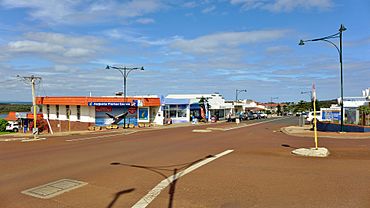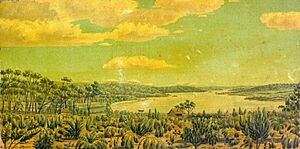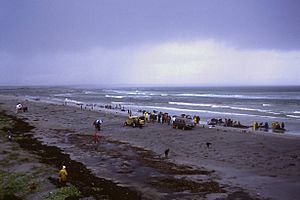Augusta, Western Australia facts for kids
Quick facts for kids AugustaWestern Australia |
|||||||||
|---|---|---|---|---|---|---|---|---|---|

Blackwood Avenue, Augusta, 2015
|
|||||||||
| Established | 1830 | ||||||||
| Postcode(s) | 6290 | ||||||||
| Elevation | 14 m (46 ft) | ||||||||
| Area | [convert: needs a number] | ||||||||
| Location | |||||||||
| LGA(s) | Shire of Augusta-Margaret River | ||||||||
| State electorate(s) | Warren-Blackwood | ||||||||
| Federal Division(s) | Forrest | ||||||||
|
|||||||||
Augusta is a town on the southwest coast of Western Australia. It is where the Blackwood River meets Flinders Bay. This town is very close to Cape Leeuwin, which is the furthest southwest point of the Australian continent. In 2016, about 1,100 people lived in Augusta.
Augusta is part of the Shire of Augusta-Margaret River, which is like its local council area. You can get to Perth by a public bus service called Transwa. Augusta also has its own airport. For a long time, Augusta was a popular summer holiday spot. But since the late 1990s, more people have chosen to live there permanently, especially for retirement. This has changed the town quite a bit.
Contents
History of Augusta
Early History and First Peoples
Noongar peoples, who are Aboriginal Australians from the southwest, lived in this area for a very long time. Scientists believe they were here for about 45,000 years before Europeans arrived. One site near Margaret River shows signs of people living there around 47,000 years ago.
Augusta is on Wardandi land. Wardandi (also spelled Wadandi) traditional owners helped archaeologists find a special spot near Flinders Bay. In 2021, they found grooves and other marks on a granite rock. These marks show that people used to grind stones to make tools there about 9,700 years ago.
European Discovery and Settlement
The coast near Augusta was first seen by Europeans in March 1622. A Dutch ship called Leeuwin (meaning Lioness) sailed by. They mapped the land north of Cape Leeuwin and named it 't Landt van de Leeuwin. Later, in 1801, Captain Matthew Flinders named the "south-western, and most projecting part of Leeuwin's Land" as Cape Leeuwin.
Augusta was officially started in 1830. In March of that year, some settlers, including John Molloy and members of the Bussell and Turner families, arrived at the Swan River Colony. The leader, Captain James Stirling, told them that most of the good land near the Swan River was already taken. He suggested they start a new settlement near Cape Leeuwin.
The next month, Captain Stirling sailed with these settlers on a ship called Emily Taylor. They explored the mouth of the Blackwood River for four days. Stirling then decided to create the new settlement there. The settlers unloaded their belongings, and the town of Augusta was officially declared.
Stirling named the town after Prince Augustus Frederick, Duke of Sussex. He was the sixth son of George III. The town was also located in Sussex County, which was one of the areas set up in Western Australia in 1829.
Growth and Changes
In the 1880s, the timber industry grew a lot. This happened after a timber mill was built nearby at Kudardup. Also, jetties were finished at Hamelin Bay and Flinders Bay, which helped move timber.
Augusta was a stop on the Busselton to Flinders Bay branch railway. This railway was run by the government from the 1920s to the 1950s. Before that, a man named M. C. Davies had his own timber railway system. It went to both Hamelin Bay and Flinders Bay jetties in the 1890s. Today, this old railway line is a walking and cycling path called the Wadandi Track.
On July 30, 1986, a large group of 114 false killer whales got stuck on Town Beach in Augusta. Over three days, many volunteers worked together to save them. These volunteers included forestry workers, wildlife officers, surfers, and local people. They carried 96 of the whales on trucks to safer waters. Then, boats, surfers, and swimmers helped guide the surviving whales out into the bay. There is now a memorial at Town Beach to remember this amazing rescue.
The Augusta boat harbour is a newer place for boats. It is located closer to Cape Leeuwin. Before this, boats used different spots between the Blackwood River mouth and the old Flinders Bay jetties.
Many tourist websites sometimes mix up Augusta and Cape Leeuwin with other nearby places. The town of Augusta now includes the old Flinders Bay community at its southern end. This area used to have a jetty, a railway end point, and a whaling station. The new Augusta Boat Harbour is actually outside the main town area.
In 2009, a local radio station called 2 Oceans FM started broadcasting from the Augusta Community Centre. You can listen to it on 97.1 MHz FM.
Bushfires in Augusta
Major Fires
In 1961, a huge area of farms, bushland, and forests was destroyed by bushfires. This happened between Margaret River and Augusta. Augusta itself was saved because an earlier fire had cleared a low-fuel zone north of the town. The people of Augusta helped care for school children who had to leave their homes in Karridale and Kudardup.
Another bushfire threatened Augusta in 2011. More than 200 people had to leave their homes. The fire had already burned a large area before it reached the edge of East Augusta. Luckily, firefighters got it under control, and no homes were destroyed.
In January 2018, the town was again threatened by a bushfire.
Tourism and Culture
Augusta hosts some events for the CinefestOZ film festival each year. This festival shows movies and holds events in Augusta in late August.
See Also
 In Spanish: Augusta (Australia Occidental) para niños
In Spanish: Augusta (Australia Occidental) para niños




